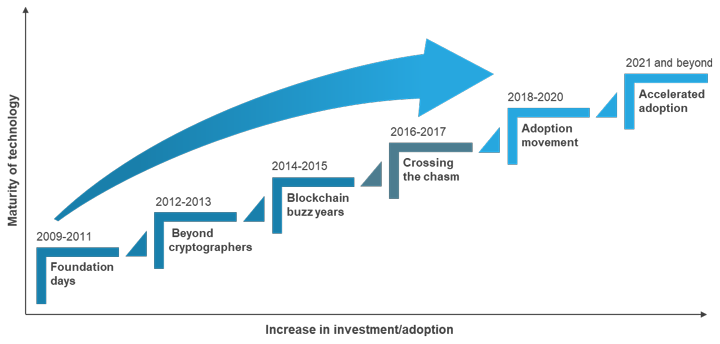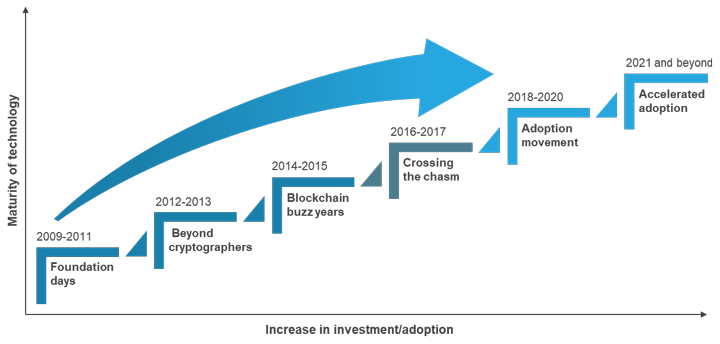AI/Automation
Blockchain Adoption Journey and Impact on Financial Services Industry
Blockchain is increasingly viewed as a ground-breaking technology with potential to disrupt industries by enabling process efficiencies, cost optimization, and building new operating and revenue models. Everest Group research suggests that almost 60% of all blockchain use cases are focused on the financial services industry since the genesis of this technology from the cryptocurrency bitcoin. Some of the use cases of blockchain in financial services are FX settlement, real-time payments, OTC derivatives clearing, P2P lending, cross-border lending, compliance reporting/audit, securities Issuance, P2P insurance, trade finance, KYC as a shared service, event-driven insurance, and core banking.
While blockchain does offer significant benefits, it is not a silver bullet. Currently, there are several roadblocks to its adoption and thus financial services institutions need to evaluate and strategize carefully where and how blockchain can be best utilized.
Let us explore the potential benefits and challenges of blockchain adoption in different areas of banking and also at the enterprise level besides looking at the future roadmap of the technology.
Challenges and Benefits of Blockchain in Banking
The current process for KYC, syndicated loans, and corporate action is complex and inefficient because of the number of parties/intermediaries involved and non-standardized, manual processes that also have some digital processes wrapped around them. For example, centralized agencies, such as the Society for Worldwide Interbank Financial Telecommunication (SWIFT), can help reduce banks’ workload and create a standardized format for documents required for KYC processes. However, the centralized nature of such an agency itself is an issue because of the time required to process the various KYC requirements of different banks’. Broadly, the challenges can be divided into three areas.
- Complex regulations
- Paper-based back-end processes
- Non-standardized processes
On the other hand, blockchain adoption can drive several benefits within banking:
Efficiency improvement
Blockchain, due to its decentralized nature, can help improve process efficiency once the process is standardized. For example, once a customer’s KYC process is done, the information can be made accessible to all nodes with the customer’s permission, eliminating the need to repeat the KYC process for customers who have multiple accounts.
Operational cost reduction
From an operational lens, blockchain can drive significant headcount efficiencies by streamlining the manual onboarding process. The use of blockchain in syndicated loans can also reduce reliance on intermediaries for processing the loans, thus reducing operational costs and risks.
Data security
Blockchain also ensures the security of stored data due to its immutable nature. Centralized databases are more prone to attack; blockchain, on the other hand, publishes the information on multiple nodes that must reach a consensus to validate a transaction, reducing the risk of attack.
Story of Enterprise Grade Blockchain Adoption Journey

The enterprise blockchain adoption story between 2009 and 2018 has been promising with financial services witnessing the highest rate of adoption. There have been major investments around developing PoCs and building consortia which have laid the foundation for scaling adoption of blockchain. 2018 witnessed considerable progress from PoCs to live deployments of blockchain particularly in financial services, where more than 22% of the PoCs moved into the live deployment stage. Offerings such as Blockchain-as-a-Service from leading technology firms have further prepared the industry participants for adoption. Though adoption is on the rise (as shown in the diagram below), there are challenges that enterprises need to address when adopting the technology.

Challenges to Enterprise Blockchain Adoption
It is evident that blockchain holds a lot of potential especially in the financial services industry. However, like any new technology, it needs to overcome the challenges to adoption. Some of the key issues/challenges that need to be resolved to accelerate blockchain adoption are:
- Talent gap: The industry is facing a demand-supply gap in blockchain talent of around 60%3
- Scaling for the future: The industry is facing challenges in moving from pilot to production due to factors such as technology maturity, interoperability, and testing tools
- Security & governance: The underlying blockchain technology brings inherent security features, however the blockchain-based business applications and infrastructure require collaboration of multiple entities in an ecosystem and is yet to be tested for enterprise-level security across industries
- Regulations and industry standards: Lack of industry standards and regulatory approach to the new business and operating models enabled by (or required for) blockchain adoption is a key adoption challenge
- Investing in the right business use cases with quantifiable outcomes: The initial hype around the potential of blockchain technology has made the technology appear as a cool solution waiting for a problem to prove its worth. Enterprises need to prioritize business use cases and define metrics to measure business outcomes
- Achieving consensus for ecosystem play: Blockchain technology is by nature dependent on ecosystem play to maximize its benefit. Currently, the adoption of blockchain has been mainly driven by industry leaders who have taken a siloed approach
Structured Approach to Blockchain Adoption
While it is true that blockchain can help solve some of the inefficiencies in the various processes of financial institutions, financial services enterprises need to take a structured approach to blockchain adoption which will help to address the challenges and maximize the benefits.

Blockchain adoption should not end up as a theoretical exercise divorced from the real business environment. And thus, enterprises need to take an objective approach to the ways blockchain can solve business problems and rank opportunities based on potential business use cases and their impact and ease of adoption. Ease of adoption of a use case is driven by process criticality, data confidentiality, process reengineering needs, existing technology investments, and current data standards. Business impact of adoption of use case is driven by the potential for cycle time reduction, effort elimination, and new business. Blockchain use cases that are high on both ease of adoption and business impact are among the ideal ones to adopt.
Enterprises need to define data structures, standards, and actors before taking the plunge. It would be imperative to identify the data producers, owners, processors, regulators, consumers, and authorizers. There is a need to align incentives for each participant and create governance for shared value creation. For example, in a KYC use case, data is being curated by the banks, owned by individuals, governed by regulatory bodies, and processed by banks and third parties. To enable a KYC process on a blockchain-based platform, all these entities will need to collaborate and will share the benefit of using an industry platform through cost mutualization, better customer experience, and reduction in frauds.
KYC is also a good example of ecosystem thinking, which is vital to maximizing value from blockchain adoption which needs a network effect for scaling value.
The future of blockchain adoption will require reimagining current business models that will include prosumers connected in a networked economy and have code-driven alignment on business incentives across ecosystem participants to ensure governance, standards, and eventually accelerated and scaled adoption.




